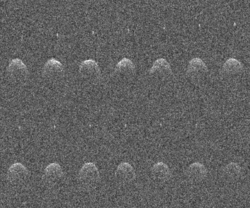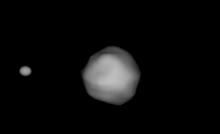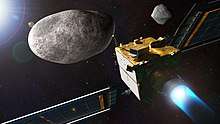65803 Didymos
65803 Didymos, provisional designation 1996 GT, is a sub-kilometer asteroid and synchronous binary system, classified as potentially hazardous asteroid and near-Earth object of both the Apollo and Amor group. The asteroid was discovered in 1996, by the Spacewatch survey at Kitt Peak, and its small 160-metre minor-planet moon was discovered in 2003, named Dimorphos. Due to its binary nature, it was then named "Didymos", the Greek word for twin.
 The radar images of Didymos and its satellite taken by the Arecibo Observatory in 2003. | |
| Discovery [1] | |
|---|---|
| Discovered by | Spacewatch |
| Discovery site | Kitt Peak National Observatory |
| Discovery date | 11 April 1996 |
| Designations | |
| (65803) Didymos | |
| Pronunciation | /ˈdɪdɪmɒs/[2] |
Named after | Greek word for "Twin"[3] |
| 1996 GT | |
| NEO · PHA Apollo [1] · Amor [4] | |
| Orbital characteristics [1] | |
| Epoch 4 September 2017 (JD 2458000.5) | |
| Uncertainty parameter 0 | |
| Observation arc | 21.04 years (7686 days) |
| Aphelion | 2.2760 AU |
| Perihelion | 1.0133 AU |
| 1.6446 AU | |
| Eccentricity | 0.3839 |
| 2.11 yr (770 days) | |
| 204.19° | |
| 0° 28m 2.28s / day | |
| Inclination | 3.4083° |
| 73.209° | |
| 319.30° | |
| Known satellites | 1 [5][6] |
| Earth MOID | 0.0404 AU · 15.7 LD |
| Physical characteristics | |
| Dimensions | 0.78±0.08 km[1] 0.800 km (taken)[7] |
| 2.2593±0.0002 h[8] 2.26±0.01 h[7][6] | |
| 0.15 (derived)[7] | |
| SMASS = Xk[1] · X[7] | |
| 18.0[1] · 18.16[7][8][9] · 18.16±0.03[10] | |
Didymos is the target of the proposed AIDA asteroid-mission to test the viability of asteroid impact avoidance by collision with a spacecraft.
Discovery
Didymos was discovered on 11 April 1996, by the University of Arizona Steward Observatory's Spacewatch survey using its 0.9-metre telescope at Kitt Peak National Observatory in Arizona, United States. The binary nature of the asteroid was discovered by others; suspicions of binarity first arose in Goldstone delay-Doppler echoes, and these were confirmed with an optical lightcurve analysis, along with Arecibo radar imaging on 23 November 2003.[4]
Orbital characteristics
Didymos orbits the Sun at a distance of 1.0–2.3 AU once every 2 years and 1 month (770 days). Its orbit has an eccentricity of 0.38 and an inclination of 3° with respect to the ecliptic. Its approach to Earth in November 2003 was especially close (in relative terms), with a distance of 7.18 million km; it will not come that near until November 2123, with a distance of 5.9 million km. Didymos also occasionally passes very close to Mars: 4.69 million km in 2144.[1]
Physical characteristics

In the SMASS classification, Didymos was classified as an Xk-type asteroid, which transitions from the X-type to the rare K-type asteroids.[1] Subsequent visible and near-infrared spectroscopy showed it to be silicate in nature.[11] It rotates rapidly, with a period of 2.26 hours and a brightness variation of 0.08 magnitude (U=3/3), which indicates that the body has a nearly spheroidal shape.[7][8][6]
Satellite
Didymos is a binary asteroid with a satellite in its orbit. The minor-planet moon, named Dimorphos,[12] moves in a mostly circular retrograde orbit [13] with an orbital period of 11.9 hours.[7][lower-alpha 1] It measures approximately 160 metres (520 ft) in diameter compared to 780 metres (2,560 ft) for its primary (a mean-diameter-ratio of 0.22).[5] Prior to the official naming of Dimorphos, it was known by its provisional designation S/2003 (65803) 1 and has been informally known as "Didymoon" or "Didymos B".[14][12]
Naming
This minor planet was named "Didymos", Greek for "twin", due to its binary nature.[3] The name was suggested by the discoverer, University of Arizona Lunar and Planetary Lab astronomer Joseph Montani, who made the naming proposal to the International Astronomical Union after the binary nature of the object was detected. The approved naming citation was published on 13 July 2004 (M.P.C. 52326).[15]
The asteroid moon's name comes from the word "Dimorphos", Greek for "having two forms".[16] The meaning of the name represents how the form of Dimorphos's orbit will change after the DART spacecraft impacts the moon.[12] Appropriately, Dimorphos serves dual roles as a both a test target and a part of a blueprint for future planetary protection.[12] The name of the moon was suggested by planetary scientist Kleomenis Tsiganis at the Aristotle University of Thessaloniki.[17]
Proposed exploration

Didymos is the target of the proposed robotic Asteroid Impact & Deflection Assessment (AIDA) mission, a collaboration between ESA and NASA.[18][19] While the European spacecraft (Hera) remains in proposal stage, NASA announced it would proceed with the impactor portion of the mission, called Double Asteroid Redirection Test or DART. The NASA mission is intended to test whether a spacecraft impact could successfully deflect an asteroid on a collision course with Earth. DART will be the first spacecraft to intentionally target an asteroid known to have a minor-planet moon (243 Ida was visited by the Galileo spacecraft but its moon was a surprise). Didymos is the most easily reachable asteroid of its size from Earth, requiring a delta-v of only 5.1 km/s for a spacecraft to rendezvous, compared to 6.0 km/s to reach the Moon.[20] DART will be launched in July 2021 for an impact in October 2022.[21] ESA's Hera mission was approved in November 2019 for a launch in 2024, to arrive at Didymos in January 2027. It will survey the dynamical effects of the DART impact and measure the characteristics of the crater made by DART.[21]
See also
- List of asteroids visited by spacecraft
Notes
- Lightcurve plots of 65803 Didymos, Palmer Divide Observatory, B. D. Warner
References
- "JPL Small-Body Database Browser: 65803 Didymos (1996 GT)" (2017-04-27 last obs.). Jet Propulsion Laboratory. Retrieved 28 June 2017.

- "didymous". Oxford English Dictionary (3rd ed.). Oxford University Press. September 2005. (Subscription or UK public library membership required.)
- Schmadel, Lutz D. (2006). "(65803) Didymos [1.64, 0.38, 3.4]". Dictionary of Minor Planet Names – (65803) Didymos, Addendum to Fifth Edition: 2003–2005. Springer Berlin Heidelberg. p. 225. doi:10.1007/978-3-540-34361-5_2677. ISBN 978-3-540-34361-5.
- "65803 Didymos (1996 GT)". Minor Planet Center. Retrieved 12 March 2017.
- Johnston, Robert (20 September 2014). "(65803) Didymos". johnstonsarchive.net. Retrieved 28 June 2017.
- Pravec, P.; Benner, L. A. M.; Nolan, M. C.; Kusnirak, P.; Pray, D.; Giorgini, J. D.; et al. (November 2003). "(65803) 1996 GT". IAU Circ. 8244 (8244): 2. Bibcode:2003IAUC.8244....2P. Retrieved 12 March 2017.
- "LCDB Data for (65803) Didymos". Asteroid Lightcurve Database (LCDB). Retrieved 12 March 2017.
- Pravec, P.; Scheirich, P.; Kusnirák, P.; Sarounová, L.; Mottola, S.; Hahn, G.; et al. (March 2006). "Photometric survey of binary near-Earth asteroids". Icarus. 181 (1): 63–93. Bibcode:2006Icar..181...63P. doi:10.1016/j.icarus.2005.10.014. Retrieved 12 March 2017.
- Kitazato, K.; Abe, M.; Mito, H.; Tarusawa, K.; Soyano, T.; Nishihara, S.; et al. (March 2004). "Photometric Behaviour Dependent on Solar Phase Angle and Physical Characteristics of Binary Near-Earth-Asteroid (65803) 1996 GT". 35th Lunar and Planetary Science Conference: 1623. Bibcode:2004LPI....35.1623K. Retrieved 12 March 2017.
- Pravec, Petr; Harris, Alan W.; Kusnirák, Peter; Galád, Adrián; Hornoch, Kamil (September 2012). "Absolute magnitudes of asteroids and a revision of asteroid albedo estimates from WISE thermal observations". Icarus. 221 (1): 365–387. Bibcode:2012Icar..221..365P. doi:10.1016/j.icarus.2012.07.026. Retrieved 12 March 2017.
- de León, J.; Licandro, J.; Serra-Ricart, M.; Pinilla-Alonso, N.; Campins, H. (28 July 2010). "Observations, compositional, and physical characterization of near-Earth and Mars-crosser asteroids from a spectroscopic survey". Astronomy and Astrophysics. 517: A23. doi:10.1051/0004-6361/200913852.
- Talbert, Tricia (23 June 2020). "NASA's First Planetary Defense Mission Target Gets a New Name". NASA. Retrieved 23 June 2020.

- Scheirich, P.; Pravec, P.; Jacobson, S.A.; Ďurech, J.; Kušnirák, P.; Hornoch, K.; Mottola, S.; Mommert, M.; Hellmich, S.; Pray, D.; Polishook, D.; Krugly, Yu.N.; Inasaridze, R.Ya.; Kvaratskhelia, O.I.; Ayvazian, V.; Slyusarev, I.; Pittichová, J.; Jehin, E.; Manfroid, J.; Gillon, M.; Galád, A.; Pollock, J.; Licandro, J.; Alí-Lagoa, V.; Brinsfield, J.; Molotov, I.E. (2015). "The binary near-Earth Asteroid (175706) 1996 FG3 — an observational constraint on its orbital evolution". Icarus. 245: 56–63. arXiv:1406.4677. Bibcode:2015Icar..245...56S. doi:10.1016/j.icarus.2014.09.023.
- "Telescopes focus on target of ESA's asteroid mission" at phys.org (30 June 2015)
- "MPC/MPO/MPS Archive". Minor Planet Center. Retrieved 12 March 2017.
- "MPEC 2020-M83 : (65803) Didymos I = Dimorphos". Minor Planet Center. International Astronomical Union. 23 June 2020.
- "IAU Approves Name of Target of First NASA and ESA Planetary Defence Missions". International Astronomical Union. 23 June 2020.
- "AIDA: Asteroid Impact and Deflection Assessment mission under study at ESA and NASA" (PDF). Observatoire de la Côte d'Azur. February 2015. Retrieved 28 June 2017.
- "Asteroid Impact & Deflection Assessment". ESA. Retrieved 28 June 2017.
- "Delta-v for spacecraft rendezvous with all known near-Earth asteroids". 2010. Retrieved 7 October 2010.
- Numerical modelling of the DART impact and the importance of the Hera mission. Sabina D. Raducan, Thomas M. Davison, Gareth S. Collins. PDC 2019. Washington, D.C., USA.
External links
- Asteroids with Satellites, Robert Johnston, johnstonsarchive.net
- Dictionary of Minor Planet Names, Google books
- Discovery Circumstances: Numbered Minor Planets (65001)-(70000) – Minor Planet Center
- 65803 Didymos at NeoDyS-2, Near Earth Objects—Dynamic Site
- Ephemeris · Obs prediction · Orbital info · MOID · Proper elements · Obs info · Close · Physical info · NEOCC
- 65803 Didymos at the JPL Small-Body Database
